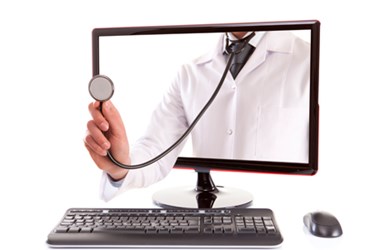6 Telemedicine Predictions For 2020
By Kayla Matthews, Productivity Bytes

While house calls might be a thing of the past, telemedicine has bought doctor's appointments back into the patient's living room.
These systems connect patients and practitioners via video chat on the patient's computer or cell phone, enabling individuals who don't have the means or the time to make a trip to the office to still take care of their physical and mental health. While it hasn't been around long, telemedicine is expected to take off in 2020 and beyond.
Here are some predictions for the field of telemedicine for the coming year.
1. More Medicare Recipients Will Utilize Telemedicine
While some insurance providers covered part or all of the cost of telemedicine appointments in 2019, Medicare was not one of them, at least not for patients who didn't meet all five of the provider's statutory conditions for telehealth. These included things like being located in a rural area.
While those living in rural areas also can benefit from telemedicine, they aren't the only ones that would like to take advantage of having a digital doctor in their living room.
In 2020, Medicare is expanding their reimbursement schedule for telemedicine services, meaning more retirees and others who might not be able to make the trip to a hospital or medical facility on their own will have access to this digital house call. This also will help to reduce some of the exorbitant medical spending that are impacting patients around the country.
According to the Centers for Medicare and Medicaid Services, healthcare spending makes up nearly 18 percent of the country's Gross Domestic Product, higher than it's ever been.
2. Remote Patient Monitoring Will Become More Common
Remote patient monitoring or RPM can be a valuable tool for physicians who care for elderly patients or those with chronic conditions. It can provide the patient with the security they need to live independently, knowing that a remote system is monitoring their vitals and will send an alert or emergency medical services if there is a problem. It's also a valuable tool for physicians who are carrying out telemedicine appointments, giving them insights into their patient's health without ever having to see them in the office.
CMS is also expanding Medicare reimbursements for remote monitoring as part of the 2020 Physician Fee Schedule, improving patient care and create more cost-effective options for remote physicians and their patients.
3. Telemedicine Will Reach An All-Time High In The U.S.
Telemedicine is growing in popularity but it hasn't reached mainstream status. That will likely change in 2020 and may start to change even earlier than that.
Telehealth is already becoming a popular option for flu-related visits. These visits have increased 43 percent since last year and will likely continue to increase exponentially with each successive annual flu season.
During flu season, telemedicine visits allow patients to seek out the care that they need without bringing home the flu, courtesy of an office visit. This is also incredibly valuable during flu season for anyone with a compromised immune system for whom a flu virus could be dangerous or even fatal.
4. The U.S. Isn't The Only Country Investing In Telemedicine
The United States isn't the only country that is starting to realize that telemedicine is a good idea for countries with large populations. China is in the process of investing 65.7 billion yuan ($9.47 billion) to digitize its healthcare system, including implementing a massive telehealth system that should be in place by 2022. This telemedicine system will ideally cover 70 percent of the country's public hospitals.
This massive investment also will help to improve regional connectivity within the country. Currently, only 49 percent of China's hospitals have a regional information platform that they can draw on.
5. 5G Mobile Internet Will Change Both Telehealth And Medicine
Most cell phone companies are working toward 5G, the latest incarnation of mobile internet. This upgrade is supposed to provide fast data transfers with little to no latency. Not only will it make it easier for patients to stream video — it has the potential to turn both the telemedicine industry and healthcare in general on its ear.
The connection between doctor and patient will be nearly instantaneous with no lag and no latency to hinder communication. Surgeons will be able to conduct delicate robot-assisted surgeries from across the country without worrying if a lag spike might kill their patient.
For telehealth patients, the 5G rollout will make these practices more accessible. While it won't have any impact on insurance providers or the cost of a telemedicine appointment, it will make completing that initial connection that much simpler.
6. Cybersecurity Will Be An Even Bigger Challenge In 2020
Whenever a system is networked, there is always the potential for hackers to invade it and use it for their own ends. Even MedTech hasn't been immune to these problems, with anesthetic machines and insulin pumps that have both been found to be vulnerable to attack.
As telemedicine moves into the mainstream in 2020, cybersecurity will be a bigger challenge than ever. It will be up to IT and cybersecurity teams to keep both patients and physicians secure as they communicate remotely.
While a hacked telehealth appointment isn't as scary as a hackable anesthetic machine where the hacker could change the amount of anesthetic that a patient receives, it still presents a considerable threat and in 2020 and beyond, IT teams will need to be vigilant.
Looking Forward
Telemedicine is poised to hit the mainstream, whether the healthcare industry is ready or not. Preparation and adoption are no longer optional — at this point, becoming telehealth-friendly will likely become a necessity for most hospitals and healthcare facilities.
About The Author
Kayla Matthews is a MedTech writer whose work has appeared on HIT Consultant, Medical Economics and HITECH Answers, among other industry publications. To read more from Kayla, please connect with her on LinkedIn, or visit her personal tech blog at https://productivitybytes.com.
